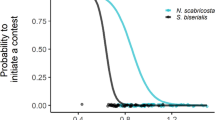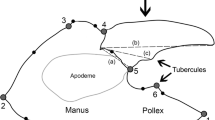Abstract
An individual’s metabolic competence is important when escalating to costly behaviours in agonistic encounters. The use of broken shells in the wild induces hermit crabs to reduce their overall metabolic rate; however, these crabs perform better in size-symmetric encounters than crabs that used intact shells in the wild. Given this surprising finding, we explored whether carrying a broken shell increases the resource holding potential (RHP) of hermit crabs by building up their muscle strength. These shells are very heavy, with an unusable portion due to being broken; however, the crabs have to carry the complete structure. Additionally, we explored whether the use of broken shells induces long-lasting consequences in motivation (aggressiveness). We conducted body size asymmetric contests to decrease the relative effect of aggressiveness by increasing the effect of RHP. We predicted a decrease of the agonistic behaviours of crab that occupied broken shells in the wild (CBS) relative to those that occupied intact shells (CIS). Symmetric and asymmetric contests were conducted in pairs formed of a CBS and a CIS, both forced to abandon them and occupy a Nerita shell. The CBS had lower muscle strength, but fought at higher intensity in symmetric contests than CIS. The differences in body mass decreased the expression of agonistic behaviours of CBS relative to CIS. Prolonged poor conditions following the use of a broken shell seem to increase aggressiveness by affecting the long-term subjective resource value. Our findings highlight the role of the recent past associated with shell used on fighting performance.
Significance statement
Hermit crabs commonly fight to exchange their inadequate shell for a new one. Although high metabolic rates favour the fighting ability, crabs that occupied broken shells in the wild have low metabolism and perform better in shell fighting than crabs that used intact shells. Broken shells are heavy and larger due to having an unusable portion, but the crab has to carry the complete structure. We explored whether carrying these shells increases muscle strength and/or the aggressiveness of crabs, which might explain their fighting dynamic. Unexpectedly, crabs with broken shells were found to be weaker than those with intact ones. Instead, the use of a broken shell in the wild enhances individual aggressiveness. The results highlight that a previous history under adverse conditions can increase the likelihood of animals with functional disadvantages acquiring better resources.



Similar content being viewed by others
References
Alcaraz G, García-Cabello KN (2017) Feeding and metabolic compensations in response to different foraging costs. Hydrobiologia 787:217–227
Alcaraz G, Kruesi K (2012) Exploring the phenotypic plasticity of standard metabolic rate and its inter-individual consistency in the hermit crab Calcinus californiensis. J Exp Mar Biol Ecol 412:20–26
Alcaraz G, Chávez-Solís CE, Kruesi K (2015) Mismatch between body growth and shell preference in hermit crabs in explained by protection from predators. Hydrobiologia 743:151–156
Arce EU, Alcaraz G (2011) Shell use by the intertidal hermit crab Calcinus californiensis at different levels of the intertidal zone. Sci Mar 75:121–128
Arce E, Alcaraz G (2012) Shell preference in a hermit crab: comparison between paired shell choice trials and a multiple alternatives experiment. Mar Biol 159:853–862
Arnott G, Elwood RW (2009) Assessment of fighting ability in animal contests. Anim Behav 77:991–1004
Arnott G, Elwood RW (2010) Signal residuals and hermit crab displays: flaunt it if you have it! Anim Behav 79:137–143
Barlow GW, Rogers W, Fraley N (1986) Do Midas cichlids win through prowess or daring? It depends. Behav Ecol Sociobiol 19:1–8
Bertness MD (1981) The influence of shell-type on hermit crab growth rate and clutch size (Decapoda, Anomura). Crustaceana 40:197–205
Briffa M (2013) Contests in crustaceans: assessments, decisions and their underlying mechanisms. In: Hardy ICW, Briffa M (eds) Animal contests. Cambridge University Press, Cambridge, pp 86–112
Briffa M, Elwood RW (2000a) The power of shell rapping influences rates of eviction in hermit crabs. Behav Ecol 11:288–293
Briffa M, Elwood RW (2000b) Analysis of the finescale timing of repeated signals: does shell rapping in hermit crabs signal stamina? Anim Behav 59:159–165
Briffa M, Elwood RW (2002) Power of shell-rapping signals influences physiological costs and subsequent decisions during hermit crab shell fights. Proc R Soc Lond B 269:2331–2336
Briffa M, Elwood RW (2005) Rapid change in energy status in fighting animals: causes and effects of strategic decisions. Anim Behav 70:119–124
Briffa M, Sneddon LU (2007) Physiological constraints on contest behaviour. Funct Ecol 21:627–637
Briffa M, Sneddon LU (2010) Contest behavior. In: Westneat DF, Fox CW (eds) Evolutionary behavioral ecology. Oxford University Press, NY, pp 246–265
Briffa M, Elwood RW, Dick JTA (1998) Analysis of repeated signals during shell fights in the hermit crab Pagurus bernhardus. Proc R Soc Lond B 265:1467–1474
Briffa M, Elwood RW, Russ JM (2003) Analysis of multiple aspects of a repeated signal: power of shell rapping during shell fights in hermit crabs. Behav Ecol 14:74–79
Brown JH, Ross B, McCauley S, Dance S, Taylor AC, Huntingford FA (2003) Resting metabolic rate and social status in juvenile giant freshwater prawns, Macrobrachium rosenbergii. Mar Fresh Behav Physiol 36:31–40
Brown C, Burgess F, Braithwaite VA (2007) Heritable and experiential effects on boldness in a tropical poeciliid. Behav Ecol Sociobiol 62:237–243
Bywater CL, Angilletta MJ, Wilson RS (2008) Weapon size is a reliable indicator of strength and social dominance in female slender crayfish (Cherax dispar). Funct Ecol 22:31–316
Callander S, Bolton J, Jennions MD, Backwell PRY (2012) A farewell to arms: males with regenerated claws fight harder over resources. Anim Behav 84:619–622
Childress JR (1972) Behavioral ecology and fitness theory in a tropical hermit crab. Ecology 53:960–964
Cid LG (2012) Habilidad de combate en cangrejos ermitaños y su relación con el uso de conchas rotas en el campo. Bachelor thesis. Facultad de Ciencias, Universidad Nacional Autónoma de México
DeCarvalho TN, Watson PJ, Field SA (2004) Costs increase as ritualized fighting progresses within and between phases in the sierra dome spider, Neriene litigiosa. Anim Behav 68:473–482
Dingemanse NJ, Van der Plas F, Wright J, Reale D, Schrama M, Roff DA, Van der Zee E, Barber I (2009) Individual experience and evolutionary history of predation affect expression of heritable variation in fish personality and morphology. Proc R Soc B 276:1285–1293
Doake S, Elwood RW (2011) How resource quality differentially affects motivation and ability to fight in hermit crabs. Proc R Soc B 278:567–573
Dowds BM, Elwood RW (1983) Shell wars: assessment strategies and the timing of decisions in hermit crab shell fights. Behaviour 85:1–24
Dugatkin LA, Reeve HK (1998) Game theory and animal behavior. Oxford University Press, New York, NY
Elwood RW, Pothanikat RME, Briffa M (2006) Honest and dishonest displays, motivational state and subsequent decisions in hermit crabs shell fights. Anim Behav 72:853–859
Emlen DJ (2014) Animal weapons: the evolution of battle. Henry Holt and Company, New York
von Ende CN (1993) Repeated measures analysis: growth and other time dependent measures. In: Scheiner SM, Gurevich J (eds) Design and analysis of ecological experiments. Chapman & Hall, New York, pp 113–137
Enquist M, Leimar O (1983) Evolution of fighting behaviour: decision rules and assessment of relative strength. J Theor Biol 102:387–410
Enquist M, Leimar O (1987) Evolution of fighting behaviour: the effect of variation in resource value. J Theor Biol 127:187–205
Gherardi F (2006) Fighting behavior in hermit crabs: the combined effect of resource holding potential and resource value in Pagurus longicarpus. Behav Ecol Sociobiol 59:500–510
Hack MA (1997) The energetic costs of fighting in the house cricket, Acheta domesticus L. Behav Ecol 8:28–36
Hammerstein P, Parker GA (1982) The asymmetric war of attrition. J Theor Biol 96:647–682
Hazlett BA (1966) Factors affective the aggressive behavior of the hermit crab Calcinus tibicen. Z Tierpsychol 23:655–671
Hofmann HA, Schildberger K (2001) Assessment of strength and willingness to fight during aggressive encounters in crickets. Anim Behav 62:337–348
Huey RB, Stevenson RD (1979) Integrating thermal physiology and ecology of ectotherms: a discussion of approaches. Amer Zool 19:357–366
Hunt J, Brooks R, Jennions MD, Smith MJ, Bentsen CL, Bussière (2006) High-quality male field crickets invest heavily in sexual display buy die young. Nature 432:1024–1027
Hurd PL (2006) Resource holding potential, subjective resource value, and game theoretical models of aggressiveness signalling. J Theor Biol 241:639–648
Huyghe K, Vanhooydonck B, Scheers H, Molina-Borja M, Van Damme R (2005) Morphology, performance and fighting capacity in male lizards, Gallotia galloti. Funct Ecol 19:800–807
Irschick DJ, Herrel A, Vanhooydonck B, Huyghe K, Van Damme R (2005) Locomotor compensation creates a mismatch between laboratory and field estimates of escape speed in lizards: a cautionary tale for performance-to-fitness studies. Evolution 59:1579–1587
Killen SS, Mitchell MD, Rummer JL, Chivers DP, Ferrari MCO, Meekan MG, McCormick MI (2014) Aerobic scope predicts dominance during early life in a tropical damselfish. Funct Ecol 28:1367–1376
Lailvaux SP, Herrel A, VanHooydonck B, Meyers JJ, Irschick DJ (2004) Performance capacity, fighting tactics and the evolution of life-stage male morphs in the green anole lizard (Anolis carolinensis). Proc R Soc B 271:2501–2508
Lan W-T, Hsu Y (2011) Prior contest experience exerts a long-term influence on subsequent winner and loser effects. Front Zool 8:28
Libersat F, Pflueger H-J (2004) Monoamines and the orchestration of behavior. Bioscience 54:17–25
Lupien SJ, McEwen BS, Gunnar MR, Heim C (2009) Effects of stress throughout the lifespan on the brain, behaviour and cognition. Nat Rev Neurosci 10:434–445
Maan ME, Groothuis TGG, Wittenberg J (2001) Escalated fighting despite predictors of conflict outcome: solving the paradox in a South American cichlid fish. Anim Behav 62:623–634
Maynard Smith J, Parker GA (1976) The logic of asymmetric contests. Anim Behav 24:159–175
Mohamad R, Monge J-P, Goubault M (2010) Can subjective resource value affect aggressiveness and contest outcome in parasitoid wasp? Anim Behav 80:629–636
Moscicki MK, Hurd PL (2015) Sex, boldness and stress experience affect convict cichlid, Amatitlania nigrofasciata, open field behaviour. Anim Behav 107:105–114
Mowles SL, Briffa M (2011) Forewarned is forearmed: early signals of RHP predict opponents fatigue in hermit crab shell fights. Behav Ecol 23:1324–1329
Mowles SL, Cotton PA, Briffa M (2011) Flexing the abdominals: do bigger muscles make better fighters. Biol Lett 7:358–360
Parker GA (1974) Assessment strategy and the evolution of fighting behaviour. J Theor Biol 47:223–243
Sneddon LU, Huntingford FA, Taylor AC, Orr JF (2000) Weapon strength and competitive success in the fights of shore crabs (Carcinus maenas). J Zool 250:397–403
Solanas A, Salafranca L, Riba C, Sierra V, Leiva D (2006) Quantifying social asymmetric structures. Behav Res Methods 38:390–399
Solanas A, Leiva D, Sierra V, Salafranca L (2009) Measuring and making decisions for social reciprocity. Behav Res Methods 41:742–754
Tricarico E, Gherardi F (2007) Resource assessment in hermit crabs: the worth of their own shell. Behav Ecol 18:615–620
Turra A, Leite FPP (2003) The molding hypothesis: linking shell use with hermit crab growth, morphology, and shell-species selection. Mar Ecol Progr Ser 265:155–163
Yasuda C, Takeshita F, Wada S (2012) Assessment strategy in male-male contests of the hermit crab Pagurus middendorffii. Anim Behav 84:385–390
Acknowledgements
This study was supported by Programa de Apoyo a Proyectos de Investigación e Innovación Tecnológica (PAPIIT, IN-213112; IN-211915) and Consejo Nacional de Ciencia y Tecnología (CONACyT, CB-2011-167915). Thanks to Karla Kruesi for their technical assistance.
Author information
Authors and Affiliations
Corresponding author
Additional information
Communicated by D. Kemp
Rights and permissions
About this article
Cite this article
Alcaraz, G., Jofre, G.I. Aggressiveness compensates for low muscle strength and metabolic disadvantages in shell fighting: an outcome of the individual’s past. Behav Ecol Sociobiol 71, 87 (2017). https://doi.org/10.1007/s00265-017-2311-7
Received:
Revised:
Accepted:
Published:
DOI: https://doi.org/10.1007/s00265-017-2311-7




